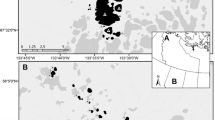Abstract
We studied the relationship between benthic invertebrates and aquatic birds at a newly constructed wetland using an avian exclosure experiment combined with counts of aquatic bird use. We measured the standing stock biomass of benthic dipterans both inside and outside exlosures. Chironomidae was the most abundant dipteran family present. Maximum chironomid standing stock biomass per pond ranged from 3.62 to 27.82 g/m2 and was comparable to that found in a number of natural systems. We monitored the abundance of ten aquatic birds species. Abundances of three aquatic bird species [American avocet (Recurvirostra americana), Wilson’s phalarope (Phalaropus tricolor), and cinnamon teal (Anas cyanoptera)] were significantly correlated with chironomid and total dipteran densities. Our experiment, however, found no significant effect of predation on invertebrate densities.
Similar content being viewed by others
Literature Cited
Bay, E. C. 1974. Predator-prey relationships among aquatic insects. Annual Review of Entomology 19:441–453.
Batzer, D. P. and V. H. Resh. 1992. Macroinvertebrates of a California seasonal wetland and responses to experimental habitats manipulation. Wetlands 12:1–7.
Benke, A. C., T. C. Van Arsdall, Jr., D. M. Gillespie, and F. K. Parrish. 1984. Invertebrate productivity in a subtropical blackwater river: the importance of habitat and life history. Ecological Monographs 54:25–63.
Benson, L. V. 1978. Fluctuations in the level of pluvial Lake Lahontam during the past 40,000 years. Quaternary Research 9:300–318.
Danks, H. V. 1978. Some effects of photoperiod, temperature, and food on emergence in three species of chironomidae (Diptera). Canadian Entomologist 110:289–300.
Davies, B. R. 1976. The dispersal of Chironomidae larvae: a review. Journal of the Entomological Society of South Africa 39:39–62.
Duffy, W.G., and D. J. LaBar. 1994. Aquatic invertebrate production in southeastern USA wetlands during winter and spring. Wetlands 14:88–97.
Hothem, R. L. and H. M. Ohlendorf. 1989. Contaminants in foods of aquatic birds at Kesterson Reservoir, California, 1985. Archives of Environmental Contamination and Toxicology 18:773–786.
Johnston, C. A. 1994. Cumulative impacts to wetlands. Wetlands 14:49–55.
Maxson, S. J. and L. W. Oring. 1980. Breeding season time and energy budgets of the polyandrous spotted sandpiper. Behaviour 74:200–263.
McKinstry, M. C and S. H. Anderson. 1994. Evaluations of wetland creation and waterfowl use in conjunction with abandoned mine lands in northeast Wyoming. Wetlands 14:284–292.
Mercier, F. and R. McNeil. 1994. Seasonal variations in intertidal density of invertebrate prey in a tropical lagoon and effects of shorebird predation. Canadian Journal of Zoology 72:1755–1763.
Merrit, R. W. and K. W. Cummins. 1984. An Introduction to the Aquatic Insects of North America, 2nd edition. Kendall/Hunt Publishing Company, Dubuque, IA, USA.
Milliken, G. A. and D. E. Johnson. 1992. Analysis of Messy Data Volume I: Designed Experiments. Van Nostrand Reinhold. New York, NY, USA.
Murkin, H. R., D. A. Wrubleski, and F. A. Reid. 1994. Sampling invertebrates in aquatic and terrestrial habitats. p. 349–369 In T. A. Bookhout (ed.) Research and Management Techniques for Wildlife and Habitats. The Wildlife Society. Bethesda, MD, USA.
Oliver, D. R. 1971. Life history of the chironomidae. Annual Review of Entomology 16:211–230.
Pinder, L. C. V. 1986. Biology of freshwater chironomidae. Annual Review Of Entomology 31:1–23.
Quammen, M. L. 1981. Use of exclosures in studies of predation by shorebirds on intertidal mudflats. Auk 98:812–817.
Quammen, M. L. 1984. Predation by shorebirds, fish, and crabs on invertebrates in intertidal mudflats: an experimental test. Ecology 65:529–537.
Rader, R. B., and C. J. Richardson. 1994. Response of macroinvertebrates and small fish to nutrient enrichment in the northern everglades. Wetlands 14:134–146.
Rice, W. R. 1989. Analyzing tables of statistical tests. Evolution 43: 223–225.
Salverson, D. 1990. Wetlands: Mitigating and Regulating Development Impacts. The Urban Land Institute. Washington, DC, USA.
SAS Institute, Inc. 1988. SAS software. SAS Institute, Inc., Cary, NC, USA.
Schneider, D. C. 1978. Equalization of prey numbers by migratory shorebirds. Nature 271:353–354.
Schneider, D. C. 1985. Migratory shorebirds: resource depletion in the tropics? p. 546–557 In Neotropical Ornithology, P. A. Buckley, M. S. Foster, E. D. Morton, R. S. Ridgely, and F. G. Buckley (eds.) Ornithological Monographs 36. American Ornithologists Union, Washington, DC, USA.
Schneider, D. C. and B.A. Harrington. 1981. Timing of shorebird migration in relations to prey depletion. Auk 98:801–811.
SPSs, Inc. 1996. Systat software. SPSS Inc. Chicago, IL, USA.
Székely, T. and Z. Bamberger. 1992. Predation of waters (Charadrii) on prey populations: an exclosure experiment. Journal of Animal Ecology 61:447–456.
Thorpe, J. H. and E. A. Bergey. 1981. Field experiments on responses of a freshwater, benthic macroinvertebrate community to vertebrate predators. Ecology, 62:365–375.
Virnstein, R. W. 1978. Predator caging experiments in soft sediments: caution advised. p. 261–273. In M. L. Wiley (ed.) Estuarine Interactions. Academic Press, New York, NY, USA.
Wetzel, R. G. and G. E. Likens. 1991. Limnological Analysis. 2nd Edition. Springer-Verlag, New York, NY, USA.
Wilson, W. H., Jr. 1989. Predation and the mediation of intraspecific competition in an infaunal community in the Bay of Fundy. Journal of Experimental Marine Biology and Ecology 132:221–245.
Wilson, W. H., Jr. 1991. The foraging ecology of migratory shorebirds in marine soft-sediment communities: the effects of episodic predation of prey populations. American Zoologist 31:840–848.
Wrubleski, D. A. and D. M. Rosenberg. 1984. overestimates of Chironomidae (Diptera) abundance from emergence traps with polystyrene floats. American Midland Naturalist 111:195–197.
Author information
Authors and Affiliations
Rights and permissions
About this article
Cite this article
Ashley, M.C., Robinson, J.A., Oring, L.W. et al. Dipteran standing stock biomass and effects of aquatic bird predation at a constructed wetland. Wetlands 20, 84–90 (2000). https://doi.org/10.1672/0277-5212(2000)020[0084:DSSBAE]2.0.CO;2
Received:
Revised:
Accepted:
Issue Date:
DOI: https://doi.org/10.1672/0277-5212(2000)020[0084:DSSBAE]2.0.CO;2




